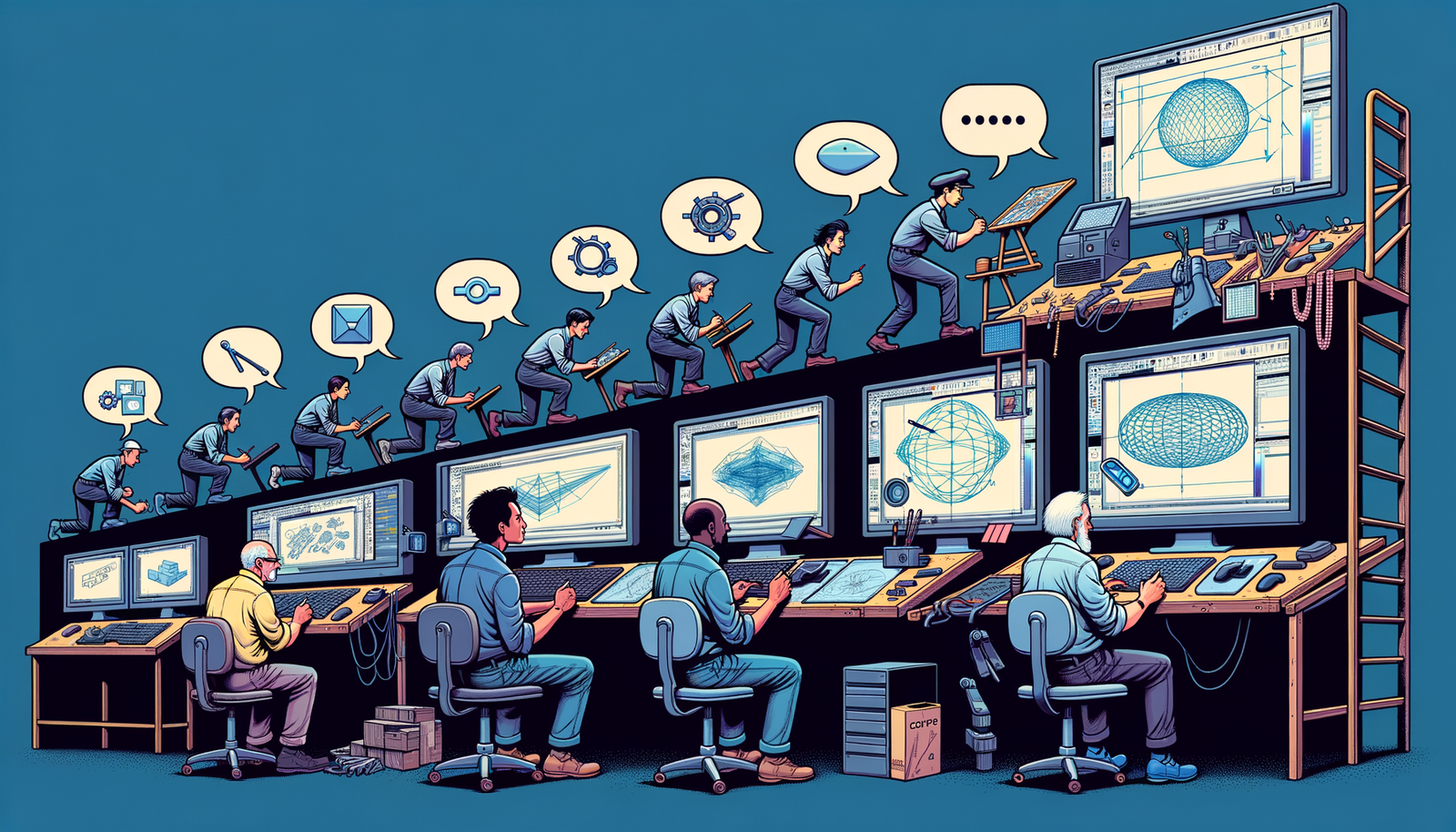Your Cart is Empty
Customer Testimonials
-
"Great customer service. The folks at Novedge were super helpful in navigating a somewhat complicated order including software upgrades and serial numbers in various stages of inactivity. They were friendly and helpful throughout the process.."
Ruben Ruckmark
"Quick & very helpful. We have been using Novedge for years and are very happy with their quick service when we need to make a purchase and excellent support resolving any issues."
Will Woodson
"Scott is the best. He reminds me about subscriptions dates, guides me in the correct direction for updates. He always responds promptly to me. He is literally the reason I continue to work with Novedge and will do so in the future."
Edward Mchugh
"Calvin Lok is “the man”. After my purchase of Sketchup 2021, he called me and provided step-by-step instructions to ease me through difficulties I was having with the setup of my new software."
Mike Borzage
Design Software History: Real-Time Collaboration Evolution in CAD Software: Transforming Design and Engineering Workflows
October 21, 2024 5 min read


Introduction to Real-Time Collaboration in CAD Software
Collaboration has always been at the heart of design and engineering, driving innovation and enabling the development of complex projects that require diverse expertise. In the early days, collaboration was often hampered by geographical limitations and the constraints of technology, forcing teams to work in silos and share updates sporadically. With the advent of digital technologies, these barriers began to erode, but it wasn’t until the integration of real-time collaboration in Computer-Aided Design (CAD) software that a significant transformation occurred. The importance of real-time collaboration in modern CAD workflows cannot be overstated; it has revolutionized the way designers and engineers work together, allowing for simultaneous input, instant feedback, and a more cohesive design process. This shift towards real-time interaction has not only increased efficiency but also enhanced the quality of designs by fostering a more dynamic exchange of ideas. A brief history of collaborative practices in CAD software reveals a journey from isolated, standalone applications to interconnected, cloud-based platforms that prioritize teamwork and communication. Understanding this evolution is crucial for appreciating the current capabilities of CAD software and anticipating future advancements that will continue to shape the industry.
Technological Foundations of Real-Time Collaboration
The ability to collaborate in real-time within CAD software is the result of several key technological advancements that have reshaped the landscape of digital design. Central to this transformation is the rise of cloud computing and storage solutions. Cloud technology provides a scalable, accessible, and secure platform for storing and sharing vast amounts of data that CAD projects typically generate. By hosting design files on cloud servers, multiple users can access and modify the same documents simultaneously from different locations, eliminating the need for cumbersome file transfers and version control issues that plagued earlier collaborative efforts.
Another critical technology is WebRTC (Web Real-Time Communication), a set of protocols that enable real-time peer-to-peer communication over the internet. WebRTC facilitates instant data sharing, video conferencing, and messaging directly within CAD applications, allowing team members to communicate seamlessly without leaving their design environment. This integration of communication protocols enhances the collaborative experience by providing immediate feedback mechanisms and reducing delays caused by switching between different communication tools.
Several software packages have effectively leveraged these technologies to offer robust real-time collaboration features. Onshape, for instance, is a fully cloud-based CAD platform that was built with collaboration at its core. It allows multiple users to work on the same model concurrently, with changes updated in real-time and a comprehensive version history to track modifications. Similarly, Autodesk Fusion 360 combines CAD, CAM, and CAE in a single cloud-enabled tool, facilitating collaboration across different disciplines involved in product development. Other notable examples include PTC Creo and Siemens NX, which have incorporated cloud capabilities and collaborative tools to enhance team workflows.
The role of APIs (Application Programming Interfaces) is also significant in facilitating integration and collaboration. APIs allow developers to extend the functionality of CAD software by integrating it with other applications and services. This means that custom tools, plugins, and automation scripts can be developed to suit specific workflows, further enhancing the collaborative capabilities of the software. APIs enable seamless data exchange between different systems, allowing for a more integrated design process that can adapt to the unique needs of each project.
Impact on Design Processes and Team Dynamics
The introduction of real-time collaboration tools in CAD software has profoundly impacted design processes and team dynamics, leading to more efficient and innovative outcomes. One of the most significant changes is the shift from linear to concurrent design processes. Traditionally, design tasks were performed sequentially, with each team member waiting for others to complete their part before proceeding. This approach often resulted in bottlenecks and delayed feedback, hindering the overall progress of projects. Real-time collaboration has dismantled these barriers by allowing all stakeholders to contribute simultaneously, accelerating the development cycle and enabling more agile responses to changes and challenges.
Enhanced communication and feedback loops have become integral to the design process. Real-time collaboration tools provide immediate visibility into the work of team members, fostering an environment where ideas can be shared and refined instantaneously. This immediacy reduces the likelihood of misunderstandings and errors, as issues can be identified and addressed promptly. Teams can engage in dynamic discussions, annotate designs on-the-fly, and iterate rapidly, leading to higher-quality outcomes and more innovative solutions.
The impact on team dynamics is multifaceted. On one hand, real-time collaboration encourages a more inclusive and participatory approach, empowering all team members to contribute their expertise and perspectives. This democratization of the design process can lead to increased morale and a stronger sense of ownership over the project. On the other hand, it introduces challenges that teams must navigate to fully realize the benefits. These challenges include managing version control, ensuring data security, and adapting to new workflows and technologies.
Design teams have implemented various solutions to address these challenges, such as:
- Establishing clear collaboration protocols: Defining roles, responsibilities, and guidelines for how and when changes should be made to shared models.
- Investing in training and support: Providing team members with the necessary skills to effectively use new collaboration tools and adapt to concurrent workflows.
- Utilizing built-in version control features: Leveraging the software's capabilities to track changes, revert to previous states, and maintain a comprehensive history of the design evolution.
- Implementing robust security measures: Ensuring that data encryption, user authentication, and access controls are in place to protect sensitive information.
By proactively addressing these challenges, design teams have been able to enhance their productivity, foster greater innovation, and strengthen team cohesion. The ability to collaborate in real-time has transformed not only how designs are created but also how teams interact and function on a fundamental level.
Future Trends and Conclusion
As technology continues to advance, several trends are poised to further shape the landscape of real-time collaboration in CAD software. One such trend is the integration with Artificial Intelligence (AI) and advanced analytics. AI has the potential to automate routine tasks, provide intelligent suggestions, and detect potential design issues before they become problematic. By integrating AI into collaborative workflows, teams can benefit from enhanced decision-making support, predictive analytics, and optimization capabilities that elevate the quality and efficiency of their designs.
The potential rise of virtual and augmented reality (VR/AR) in collaborative environments represents another exciting trend. VR and AR technologies can provide immersive experiences that allow team members to interact with digital models in three-dimensional space as if they were physical objects. This immersion can enhance spatial understanding, improve design reviews, and facilitate more effective communication of complex concepts. By combining VR/AR with real-time collaboration, teams can work together in virtual environments regardless of their physical locations, breaking down geographical barriers and fostering a new level of engagement.
In conclusion, embracing real-time collaboration tools is essential for organizations seeking to remain competitive and innovative in the modern design and engineering landscape. These tools not only streamline workflows and reduce time-to-market but also cultivate a more collaborative and creative team culture. The continued evolution of design software to enhance team interactions underscores the industry's commitment to leveraging technology for improved outcomes. As AI, VR/AR, and other emerging technologies become integrated into collaborative platforms, they will unlock new possibilities for creativity and efficiency. The future of design is one where collaboration is seamless, immersive, and intelligent, enabling teams to tackle increasingly complex challenges and drive progress in their respective fields.
Also in Design News

Cinema 4D Tip: Filmic OCIO Pipeline and Camera-Based Exposure
November 05, 2025 2 min read
Read More
Bluebeam Tip: Track accountability with the Owner field in Bluebeam Revu
November 05, 2025 2 min read
Read More
ZBrush Tip: IMM workflow for distortion‑free inserts and fast curve placement
November 05, 2025 2 min read
Read MoreSubscribe
Sign up to get the latest on sales, new releases and more …


